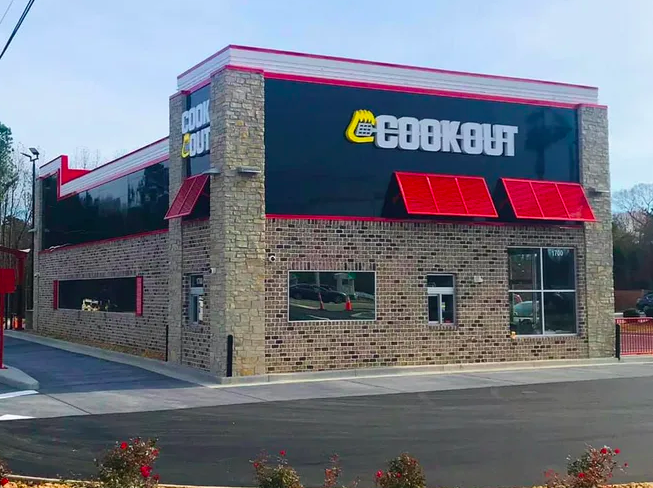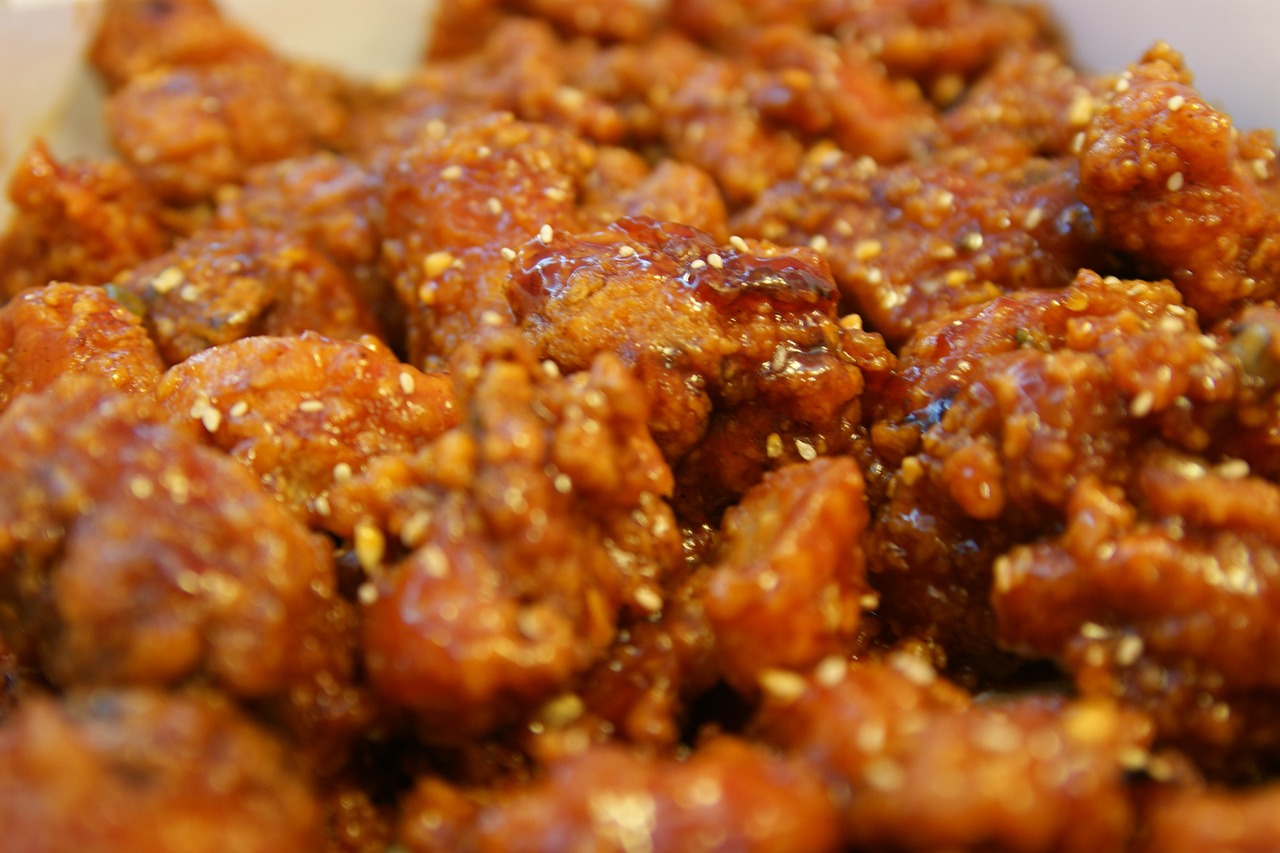McDonald’s is the largest and most well-known fast-food brand in the world. Incorporated in 1955, Ray Kroc’s company already sold its 100 millionth burger by 1958. Now, you can find a Golden Arches location in over 110 countries worldwide with a total of 38,695 stores. McDonald’s is the most valuable food chain on the planet with an estimated brand value of over $130 billion dollars. You could do a lot worse than to join forces with this iconic fast-food brand.
How much will it cost to open a McDonald’s franchise? Expect to invest between $1 million – $2.2 million to open your first restaurant depending on the location. This estimate includes the $45,000 franchise fee to join. Take our franchise quiz to find out if the Golden Arches are right for you.
But is McDonald’s still worth investing in? Based on the most recently available Financial Disclosure Document or FDD that was submitted , We explore what it takes to join Ronald McDonald’s team and dig into the details of this super-sized franchise opportunity below.
Page Contents
- Base Financial Requirements and Fees
- Average Sales and Revenue per Year
- Are McDonald’s Revenues Still Increasing or Declining?
- Top Selling Menu Items at McDonald’s + Revenue
- McDonald’s Franchise Facts
- How Much Profit Does a McDonald’s Franchise Owner Make Per Year?
- Advantages of McDonald’s Franchise
- Challenges of McDonald’s Franchise
- Is Owning a McDonald’s Right for You?
Base Financial Requirements and Fees
| Fees/Expenses | Amount Needed |
| Initial Franchise Fee | $45,000 |
| Liquid Capital | $500,000 |
| Net Worth | At least $500,000 liquidity |
| Total Investment | $1 million – $2.2 million |
Like most franchise opportunities, McDonald’s prefers franchisees with prior business ownership or management experience to join their team. Ideally, you’ve spent some time working on the floor as a manager of the fast-food chain or graduated from McDonald’s Hamburger University. Additionally, McDonald’s charges a $45,000 franchising fee with an ongoing service fee charge of 4% on gross sales. On average, franchisees pay 10.7% of total sales in rent costs.
Having a significant amount of liquid capital is important when purchasing McDonald’s franchise. McDonald’s requires a minimum of $500,000 in liquid capital, or as they write on their website “non-borrowed personal resources” for potential owners.
To purchase a new restaurant, McDonald’s requires an initial down payment that’s 40% of the total initial cost. For an existing franchisee with a track record, they only require 25% of the total cost. Funds for the down payment must be obtained through non-borrowed personal resources, such as cash on hand; debentures, bonds, and securities; vested profit sharing (as a net from taxes); and real estate or business equity exclusive from your personal residence.
Not Sure What Franchise to Start? Take Our 7-Minute Franchise Business Quiz!
McDonald’s policy requires that the buyer pay a down payment of a minimum of 25% cash when purchasing a restaurant. Any remaining balance from the price of purchase must be financed within a time of seven years or less.
Unfortunately, McDonald’s does not offer financing on its own, but they can connect you with reputable lending companies. They believe that their owners profit from the lowest lending rate percentages in the food service industry.
In addition to the basic financial requirements of the business, here are some other additional expenses and values you should be aware of:
| Additional Fees and Expenses | Values |
| Average Rent Percentage | 10.7% |
| Service Fee | 4% on gross sales |
| To Purchase an Existing Franchise | 25% of the total cost |
| To Purchase a New Franchise | 40% of the total cost |
| Required for Payment | 25% of the down payment must be cash |
The McDonald’s Franchise Disclosure Document (FDD) recommends that franchisees have at least $500,000 in working capital available at all times. Having enough working capital is important for a franchisee to cover any unexpected expenses, such as a sudden increase in food costs or a labor shortage.
Average Sales and Revenue per Year
The median annual sales volume of McDonald’s location is $2.4 million. This figure is based on data from the company’s 2022 Franchise Disclosure Document (FDD).
The median sales volume varies depending on the type of restaurant. For example, free-standing restaurants typically have higher sales volumes than restaurants located in malls or other enclosed spaces.
Not all McDonald’s locations are created equal. Location and clientele are the biggest profitability factors per unit. That said, most come out profitable based on a sustainable business model given by the company.
Are McDonald’s Revenues Still Increasing or Declining?
After all these year’s it would be easy to understand if McDonald’s sales would be flat-lining due to market saturation. But that’s not that case at all. McDonald’s total revenues continue to increase year over year. Here is a table showing the company’s revenue, expenses, and profits over the past several years:
| Year | Revenue | Expenses | Profit |
|---|---|---|---|
| 2021 | $27.8 billion | $25.4 billion | $2.4 billion |
| 2020 | $24.7 billion | $22.9 billion | $1.8 billion |
| 2019 | $23.8 billion | $21.9 billion | $1.9 billion |
| 2018 | $22.9 billion | $20.9 billion | $2 billion |
| 2017 | $22.0 billion | $20.0 billion | $2 billion |
As you can see this is a restaurant that’s clearly still in growth mode. The company’s revenue has increased by an average of 7.2% per year, its expenses have increased by an average of 6.7% per year, and its profit has increased by an average of 8.6% per year.
McDonald’s continued growth is being driven by two main factors:
- Increased global sales: The company’s global sales have increased in recent years, driven by growth in emerging markets such as China and India.
- Increased sales in existing restaurants: The company has also been able to increase sales in its existing restaurants by introducing new menu items and improving its marketing and advertising campaigns.
Top Selling Menu Items at McDonald’s + Revenue
Here is a table of sales data for McDonald’s menu items based on the FDD. If you plan to franchise a McDonald’s expect to sell a whole lot of Big Macs, McChickens, and of course French fries.
| Menu Item | Sales (in millions of US dollars) |
|---|---|
| Big Mac | 4,500 |
| McChicken | 3,500 |
| French Fries | 3,000 |
| Coca-Cola | 2,500 |
| Ice Cream Cone | 2,000 |
| Egg McMuffin | 1,500 |
| Sausage McMuffin with Egg | 1,500 |
| Hash Browns | 1,000 |
| Hotcakes | 1,000 |
| McCafé Coffee | 1,000 |
These sales figures are for all McDonald’s USA and international restaurants. It is important to note that these figures do not include sales from McDonald’s licensed restaurants, such as those located in airports and train stations.
McDonald’s Franchise Facts
- Year Founded: 1955, as McDonald’s System, Inc.
- Total Units: 38,695
- Industry: Fast Food Restaurants
How Much Profit Does a McDonald’s Franchise Owner Make Per Year?
According to the 2022 McDonald’s Franchise Disclosure Document (FDD), the average franchisee profit in the United States is $150,000 per year. However, this figure will vary depending on a number of factors, including the location of the restaurant, the size of the restaurant, and experience of the franchisee.
For example, franchise owners in expensive cities like New York or San Francisco may make more than a franchisee based in North Dakota. In addition, owner-operators who have been with McDonald’s for many years are likely to earn more than new franchisees due in part to their experience managing expenses like labor cost and food waste.
McDonald’s has a high start-up cost intended to appeal to a more experienced and deep-pocketed investor. Those with more experience tend to understand the various factors that go into profitability and the multitude of ways you can make a business more efficient. That heightened efficiency results in profit in the long run. A McDonald’s franchise can be difficult for beginners to break into compared to alternative concepts like Subway franchise, which is known bringing in more franchisees annually.
Food and paper costs are the largest set expenses for a McDonald’s location. Obviously, you need to pay for the product (hamburgers, chicken nuggets, french fries). But it’s important to consider the costs of packaging with the cups, bags, and straws that all land in the expense column for the business.
Related Reading: What’s the Real Cost (w/ Fees) to Open a Jersey Mike’s Franchise?
Food costs for a McDonald’s franchisee average $810,000 per year per unit. Paper costs average $108,000 per year per unit. This accounts for all the packaging that all McDonald’s products come with. Another obvious cost for a franchisee comes from the labor needed to staff and run the establishment. No business can run without the team to assemble the Big Mac’s and serve guests.
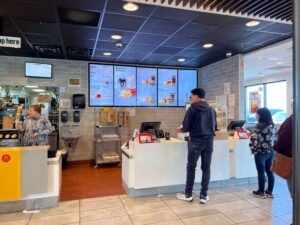
Inside a busy McDonald’s in Nevada.
In McDonald’s restaurants, labor cost falls into two tiers. The first are crew costs, which on average, come out to nearly $540,000 per year per unit. The second are manager costs, which on average, end up at around $108,000 per year per unit. Since McDonald’s is such a fast-paced restaurant, more staff will be needed to run this franchise vs. other less-popular options.
Between the McDonald’s corporation and the land these locations sit on, a franchisee must pays monthly rent payments that will cut into profits. As a reminder, a McDonald’s franchise will pay 10.7% in monthly of total sales toward monthly lease payment on top of a mandated 4% service fee for all sales. This brings the total cost for rent and fees to nearly $392,000 per unit annually.
Other business-related expenses to consider include taxes, licenses, and insurance. Regulations must be abided by and McDonald’s is not a corporation willing to cut corners with their brand.
Related Reading: How Much Does It Really Cost (w/ Fees) to Open a KFC Franchise?
Do you remember ever going to McDonald’s as a child? For many of us, we recall begging our parents for a Happy Meal that included a toy being promoted on Saturday morning cartoons or after school programming. But getting the regular exposure on television, radio, direct mail, and online isn’t free. Franchisees will pay on average $121,000 per unit per year on advertising and promotional materials and fees to help maintain top-of-mind awareness among consumers.
More expenses that are natural parts of any business include line items like utility costs, uniform linens, supplies, miscellaneous necessities, maintenance and repair, etc. A McDonald’s franchisee can expect to pay an average of nearly $154,000 per unit per year on these miscellaneous expenses.
After paying the corporation the 15% or so in fees and rent, plus the other added business costs handed down, a franchisee will be left with a 4% – 6% profit margin on average. This can be a difficult pill to swallow for many operators and something you’ll need to be okay with before getting involved.
Advantages of McDonald’s Franchise
Hopefully, you made it through that last section with a better understanding of the full scope of operations costs. Now to the good stuff!
McDonald’s is a highly successful chain for good reason. One of the world’s most recognizable logos, the Golden Arches has a name brand that you can bank on to easily get sales for decades to come. Add to that a promotional department that consistently wins awards, you’re supported by one of the greatest promotional teams of all time.
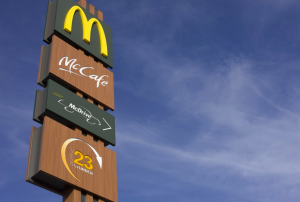
The Golden Arches.
McDonald’s requires all new franchisees take 12-18 month training courses at Hamburger University to teach them management techniques that will set them up for long-term success. It is done on the franchisee’s own part-time. Some may see this as a negative challenge, but as a model, it prepares you for the realities of managing a store.
In addition to the initial training, McDonald’s offers Hamburger University training support to all franchise owners looking to constantly improve. Seminars, conferences, and one-on-one training sessions are also included in the McDonald’s support procedure. This company does a lot to ensure its locations have franchisees that know what they are doing and are supported.
Since there are McDonald’s locations operating in more than 100 countries, the corporation has a huge list of suppliers and business ties. As a franchisee, you’ll be able to reap the benefits of those extensive connections. This can help mitigate large fluctuations in the cost of food supplies and ensure inventories are at appropriate levels.
McDonald’s is also very effective at using promotions. The company has a long history of running successful promotions, and it continues to invest in new and innovative ways to promote its products. As a result, McDonald’s is able to attract new customers, encourage repeat business, and increase sales. Here are some examples of successful promotions that McDonald’s has run that help keep the brand relevant.
- The Monopoly game is a popular promotion that has been running for over 40 years. The game gives customers the chance to win prizes, including cars, houses, and cash.
- The Happy Meal is a popular meal that is targeted at children. The meal includes a hamburger, fries, a drink, and a toy.
- The McRib is a popular sandwich that is only available for a limited time each year. The sandwich is made with pork and barbecue sauce.
Pros
- Name-brand recognition gets you customers right away.
- Award-winning promotional department.
- Recession proof business model.
- Top-end management training.
- Support through Hamburger University.
- A large list of food suppliers.
- Ability to adapt their menu to changing consumer preferences.
Challenges of McDonald’s Franchise
Getting chosen to be a franchisee isn’t guaranteed, actually, it is pretty difficult. With the upfront liquid cash requirements and overall investment required, it is steep. That said, if you can manage those initial costs, you have a sustainable business that is backed with decades of success.
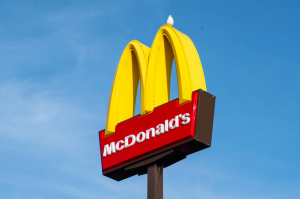
A McDonald’s Restaurant Sign.
As a franchisee, you do not get to pick a new site location. Often, the company prefers franchisees to take over existing locations, but occasionally a new location will open up, and corporate will choose the site and pay for building costs. Corporations will then pick the franchisee of their choice to run it. You may have less say on the location, which is not optimal for some but also sets you up for more success.
McDonald’s charges a somewhat high amount in fees and rent. Seeing as the corporation owns the locations and requires a 4% service fee on all sales, you will be expected to pay those shares each month with no exceptions. You need to be comfortable paying these fees and royalties before entering into an agreement to start this business. With a larger corporation, this is expected due to the larger influx of sales.
Cons
- High upfront liquid cash requirements.
- No choice in new site location.
- Nearly 15% in sales goes to McDonald’s Inc. each month for rent and service fees.
Is Owning a McDonald’s Right for You?
McDonald’s may not be the right opportunity for every entrepreneur, but it might be the right opportunity for you. In general, McDonald’s is looking for someone with significant business experience in the fast-food industry and of course sufficient investment capital to qualify.
McDonald’s has a large loyal customer fan base and global reach. They’ve continued to increase sales decade after decades. Customers are aware of this brand globally and know exactly what to expect when they enter a store.
If you’re highly motivated, eager to train in top-end management techniques, and willing to learn how to run a business from a world-renowned corporate brand, then McDonald’s could be a great fit.
Related Reading: How Much Does It Really Cost to Open a Chick-fil-A Franchise?
As always, make sure you understand the financial and time requirements necessary for new potential franchisees. Visit the McDonald’s website in the franchising section to get even more information on how to take the next steps to see if you qualify for funding.
Many say that the genius behind McDonald’s isn’t necessarily its menu, but the business model that Ray Kroc instilled. With an ability to re-design the operating costs and restructure efficiency, Mr. Kroc was able to out-grow any competition to open more stores. That momentum is continuing to this day, with constantly updating business models, you are buying into a systematic organization.



